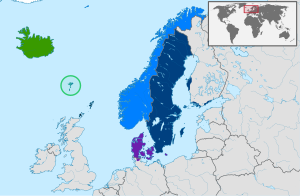
North Germanic languages
Languages of the Nordic countries / From Wikipedia, the free encyclopedia
Dear Wikiwand AI, let's keep it short by simply answering these key questions:
Can you list the top facts and stats about North Germanic language?
Summarize this article for a 10 years old
The North Germanic languages make up one of the three branches of the Germanic languages—a sub-family of the Indo-European languages—along with the West Germanic languages and the extinct East Germanic languages. The language group is also referred to as the Nordic languages, a direct translation of the most common term used among Danish, Faroese, Icelandic, Norwegian, and Swedish scholars and people.
| North Germanic | |
|---|---|
| Nordic Scandinavian | |
| Ethnicity | North Germanic peoples |
| Geographic distribution | Northern Europe |
| Linguistic classification | Indo-European
|
| Proto-language | Proto-Norse |
| Subdivisions | |
| ISO 639-5 | gmq |
| Glottolog | nort3160 |
 North Germanic-speaking lands
Continental Scandinavian languages: Insular Nordic languages:
| |
The term North Germanic languages is used in comparative linguistics,[1] whereas the term Scandinavian languages appears in studies of the modern standard languages and the dialect continuum of Scandinavia.[2][3] Danish, Norwegian and Swedish are close enough to form a strong mutual intelligibility where cross-border communication in native languages is very common, particularly between the latter two.
Approximately 20 million people in the Nordic countries speak a Scandinavian language as their native language,[4] including an approximately 5% minority in Finland. Besides being the only North Germanic language with official status in two separate sovereign states, Swedish is also the most spoken of the languages overall. 15% of the population in Greenland speak Danish as a first language.[5]
This language branch is separated from the West Germanic languages, consisting of languages like English and Dutch, to the south, and is distinct from Finnish just to the east, which belongs to the completely unrelated Uralic language family.